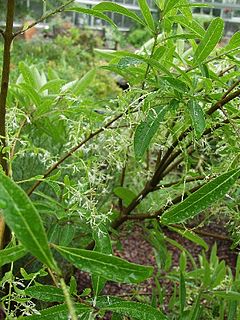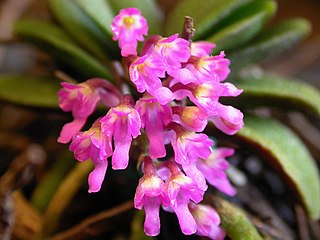| Aporosa | |
|---|---|
 | |
| Aporosa cardiosperma | |
| Scientific classification | |
| Kingdom: | Plantae |
| Clade: | Tracheophytes |
| Clade: | Angiosperms |
| Clade: | Eudicots |
| Clade: | Rosids |
| Order: | Malpighiales |
| Family: | Phyllanthaceae |
| Subfamily: | Antidesmatoideae |
| Tribe: | Scepeae |
| Genus: | Aporosa Blume |
| Synonyms [1] | |
Aporosa is a genus of flowering plant belonging to the family Phyllanthaceae, first described as a genus in 1825. [4] It is native to China, the Indian Subcontinent, Southeast Asia, Papuasia, and Queensland. [1] [5] [6] [7]
These plants are mostly dioecious trees or shrubs. [8] Four species ( A. hermaphrodita , A. heterodoxa , A. brevicaudata , and A. egreria ) have consistently bisexual flowers, although they may be functionally dioecious. [9] The seeds have brightly colored arils that are attractive to birds, which disperse the seeds. [3]
There are about 80 species. [3]
- Species [1]
- Aporosa acuminata - SW India, Sri Lanka
- Aporosa alia - Borneo
- Aporosa annulata - New Guinea, Bismarcks
- Aporosa antennifera - Borneo, Sumatra, W Malaysia
- Aporosa arborea - Borneo, Sumatra, W Malaysia, Java, S Thailand
- Aporosa aurea - Borneo, Sumatra, W Malaysia, S Thailand
- Aporosa banahaensis - Philippines, Sabah
- Aporosa basilanensis - Borneo, Basilan
- Aporosa benthamiana - Borneo, Sumatra, W Malaysia, Philippines
- Aporosa bourdillonii - Kerala
- Aporosa brassii - E New Guinea, Bismarcks
- Aporosa brevicaudata - New Guinea
- Aporosa bullatissima - Borneo
- Aporosa caloneura - Borneo
- Aporosa cardiosperma - W India, Sri Lanka
- Aporosa carrii - E New Guinea
- Aporosa chondroneura - Borneo
- Aporosa confusa - Borneo, Sumatra, W Malaysia
- Aporosa decipiens - New Guinea
- Aporosa dendroidea - Maluku
- Aporosa duthieana - Indochina
- Aporosa egregia - W New Guinea
- Aporosa elmeri - Borneo
- Aporosa falcifera - Borneo, Sumatra, W Malaysia, Sulawesi, S Thailand
- Aporosa ficifolia - Mainland Southeast Asia
- Aporosa flexuosa - New Guinea
- Aporosa frutescens - Myanmar, Thailand, Malaysia, Indonesia, Philippines
- Aporosa fulvovittata - Sabah
- Aporosa fusiformis - SW India, Sri Lanka
- Aporosa globifera - Sumatra, W Malaysia, S Thailand
- Aporosa grandistipula - Borneo, Sulawesi
- Aporosa granularis - Borneo
- Aporosa hermaphrodita - E New Guinea
- Aporosa heterodoxa - Bougainville I
- Aporosa illustris - Borneo
- Aporosa lagenocarpa - Borneo
- Aporosa lamellata - New Guinea
- Aporosa lanceolata - Sri Lanka
- Aporosa latifolia - Sri Lanka
- Aporosa laxiflora - E New Guinea, Bismarcks
- Aporosa ledermanniana - New Guinea, Bismarcks, Louisiades
- Aporosa leptochrysandra - New Guinea
- Aporosa leytensis - Philippines, Sulawesi
- Aporosa longicaudata - New Guinea
- Aporosa lucida - Malaysia, Indonesia
- Aporosa lunata - Borneo, Sumatra, W Malaysia, Java, S Thailand
- Aporosa macrophylla - Myanmar
- Aporosa maingayi - W Malaysia
- Aporosa microstachya - W Malaysia, Java, S Thailand, S Myanmar
- Aporosa misimana - E New Guinea
- Aporosa nervosa - Borneo, Sumatra, W Malaysia, S Thailand
- Aporosa nigricans - Borneo, Sumatra, W Malaysia, S Thailand
- Aporosa nigropunctata - New Guinea
- Aporosa nitida - Borneo
- Aporosa octandra - S China, SE Asia, New Guinea, Queensland
- Aporosa papuana - New Guinea, Bismarcks, Solomons
- Aporosa parvula - W New Guinea
- Aporosa penangensis - W Malaysia, S Thailand
- Aporosa planchoniana - Mainland Southeast Asia
- Aporosa praegrandifolia - New Guinea
- Aporosa prainiana - Borneo, Sumatra, W Malaysia
- Aporosa pseudoficifolia - W Malaysia, S Thailand, S Myanmar
- Aporosa quadrilocularis - Kedah, Sumatra
- Aporosa reticulata - E New Guinea
- Aporosa rhacostyla - Sarawak
- Aporosa sarawakensis - Borneo
- Aporosa sclerophylla - E New Guinea
- Aporosa selangorica - W Malaysia
- Aporosa serrata - Laos, N Thailand
- Aporosa sphaeridiophora - Philippines, Java
- Aporosa stellifera - Sumatra, W Malaysia, S Thailand
- Aporosa stenostachys - Sarawak
- Aporosa subcaudata - Borneo, Sumatra, W Malaysia
- Aporosa sylvestri - Sarawak
- Aporosa symplocifolia - Philippines
- Aporosa symplocoides - Borneo, Sumatra, W Malaysia, S Thailand
- Aporosa tetrapleura - Cambodia, Vietnam
- Aporosa vagans - New Guinea to Admiralty Is
- Aporosa villosa - Southeast Asia, Andaman & Nicobar
- Aporosa wallichii - Assam, Bangladesh, Indochina
- Aporosa whitmorei - Sumatra, W Malaysia
- Aporosa yunnanensis - Indochina, S China, Assam
- formerly included [1]
moved to other genera: Antidesma Baccaurea Drypetes Shirakiopsis
- A. bilitonensis - Baccaurea minor
- A. calocarpa - Drypetes longifolia
- A. dolichocarpa - Baccaurea javanica
- A. griffithii - Antidesma coriaceum
- A. inaequalis - Drypetes leonensis
- A. somalensis - Shirakiopsis elliptica















